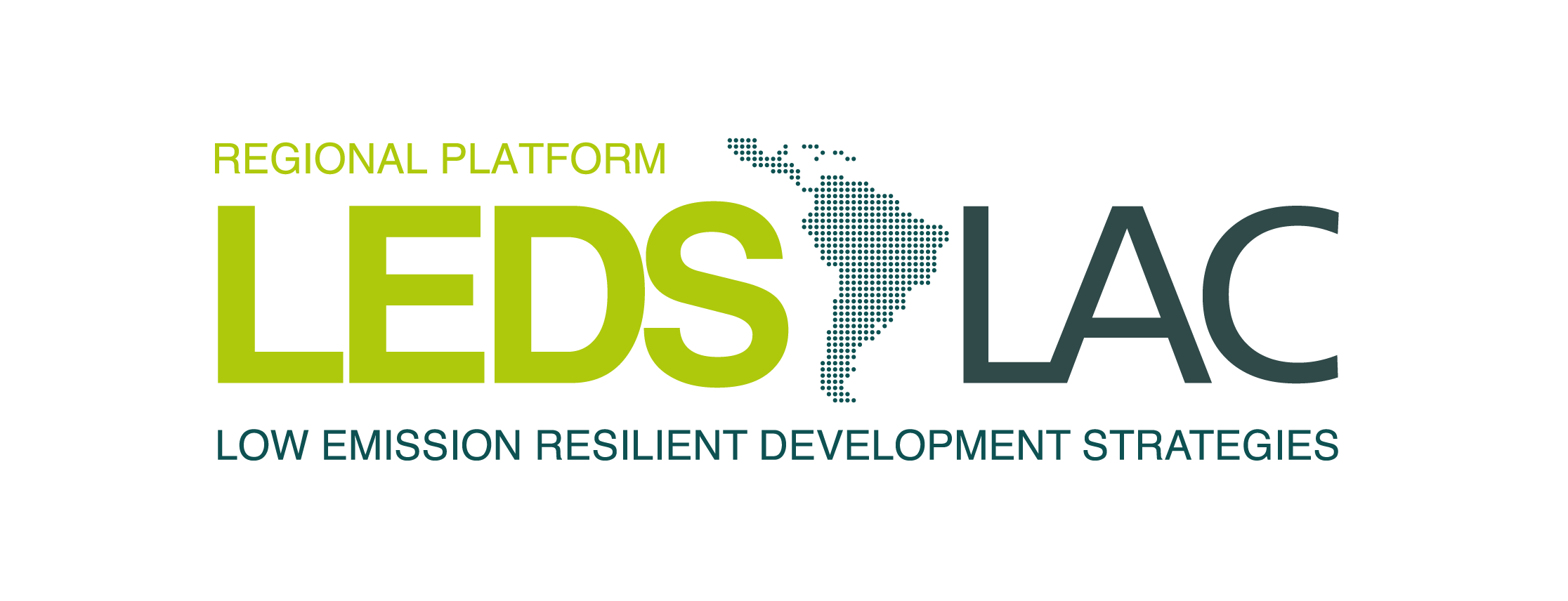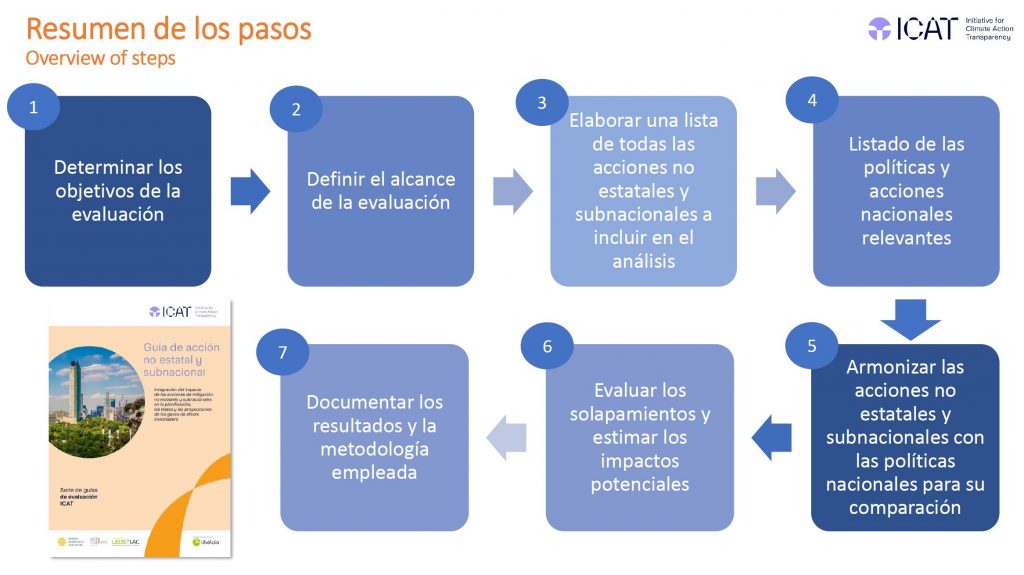Introduction
On Thursday, May 10, 2022, the webinar "Non-State and Subnational Action Guide of the Initiative for Climate Action Transparency (ICAT).)". This is the first event in a series of nine virtual sessions, co-organized between ICAT and the LEDS LAC platform, which aims to present three of the assessment guides and methodologies that ICAT has developed and that have recently been translated into Spanish.
The webinar was opened with welcoming remarks from Henning Wuester, Director of ICAT and featured presentations by Andres FloresDirector of Climate Change and Energy at WRI, who showed what the Non-State and Subnational Action Guide is and what it is useful for, while Sebastian GarinThe coordinator of the HuellaChile Program at the Ministry of the Environment gave a presentation on the experience using the HuellaChile program guide. The event was attended by 87 participants from 22 countries.
A recording of the event can be found at here while the Spanish translation of the Non-State and Subnational Action Guide can be downloaded at here and its infographic here.
Key messages
About ICAT and the translation of the impact assessment guidelines
ICAT is an initiative that supports developing countries in strengthening their climate transparency frameworks. To this end, ICAT has prepared a set of guidelines for assessing the impact of different climate policies both in terms of greenhouse gas (GHG) emission reductions and in terms of contribution to sustainable development and for assessing the potential for transformational change. The series of 10 guides provides a robust methodological approach to assist countries in their preparation for the Paris Agreement's Enhanced Transparency Framework. Its scope encompasses not only the assessment of past actions and policies but also provides methodologies to enable forward-looking planning and facilitate the tracking and monitoring of the outcomes of policies and actions included in the Nationally Determined Contributions (NDCs). With the guidelines, ICAT seeks to assist countries in the development of domestic transparency systems, in the construction and monitoring of future scenarios, and in the planning and implementation of evidence-based climate policies and actions.
In response to the demand identified, mainly from the Latin America and the Caribbean (LAC) region, ICAT has translated three of the guides in the series to contribute to the development of monitoring, reporting and verification systems that enhance climate ambition: the Sustainable Development Impact Assessment Guidancethe Evaluation guide on transformational change and the Non-State and Subnational Action Guide. These three guides play a critical role in the development and implementation of robust NDCs by helping to: (1) understand the sustainable development impact of advancing ambitious emission reduction targets; (2) understand the potential for transformational policy change to achieve the decarbonization goal; and (3) consider and incorporate subnational and non-state actor actions and measures to increase the ambition and strength of NDCs.
About the guide
There is scientific and political consensus on the climate emergency and the need for more ambitious and urgent action given that 1.5°C of global warming is likely to be exceeded in the next 10 years or even sooner, which corresponds to the aspirational goal of the Paris Agreement. The decarbonization of the economy by 2050 requires the action of all stakeholders. In this sense, the contribution of the private sector and all non-state actors, subnationals and territorial jurisdictions is very relevant.
According to WRI and its "Stories to Watch 2022" initiative, there are 83 countries with carbon neutrality goals, reflected in different forms (e.g. laws, policies, declarations). In addition, more than 1,000 cities and more than 2,000 companies with similar commitments to reach net zero emissions are quantified. The challenge is how to ensure that emission commitments are credible, and what are the pathways to achieve this? Non-State and Subnational Action Guide is a useful tool that provides an orderly and methodical (step-by-step) approach and allows analysts and decision-makers at the national level to assess the GHG emission reduction impacts of actions by non-state and subnational actors. It also allows for transparent communication of how the assessment was done and for replication if necessary. The assessment should be carried out ex anteThe guide provides a useful and user-friendly process for defining the scope of the assessment, its objectives and terms of reference, measurement parameters and assumptions. The guide provides a useful and user-friendly process for defining the scope of the assessment, its objectives and terms of reference, measurement parameters and assumptions.
Experiences using the guide
Mexico
In Mexico, the guide was applied to determine and quantify the contribution of subnational states to Mexico's NDC. Following the steps of the ICAT guide, the objective was to build a database to generate evidence on the projects carried out by 32 states and the private sector, identify their level of progress and estimate their emission reduction potential. We worked with publicly available information and conducted 27 semi-structured interviews with officials to gather information on the projects.
The results identified a greater number of mitigation projects compared to adaptation projects; the main need is the lack of resources and financing, and the main challenges are management capacity, the loss of capabilities with each change of management, and scarce human resources.
The guidance application leaves a number of lessons learned:
- Its complementarity with efforts being carried out at the national level, from INECC or SEMARNAT;
- allows knowledge to be generated from the bottom up (bottom-up) to understand the potential for subnational and private projects and commitments;
- clearly identifies gaps and needs (e.g. information, training and integration);
- allows for the evaluation of overlaps and double counting between federal and subnational actions;
- provides elements that contribute to the achievement of objectives and increased climate ambition.
Chile
When the ICAT Chile project began in 2020, there were two important contextual elements that marked its actions. First, the draft Framework Law on Climate Change was already under discussion, which proposed a goal of achieving carbon neutrality by 2050 and also included clear links with other instruments that allow linking with sectoral and territorial issues. The draft framework law is complemented by Chile's NDC, also presented in 2020, which includes an intermediate mitigation target to 2030. Second, since 2013 the HuellaChile program has been operating, a voluntary program within the Ministry of Environment that works with public and private organizations to encourage the calculation, reporting and management of GHGs within their organizational inventories. By 2020 there were more than 1,100 participating organizations, mostly from the private sector, and more than 650 seals of recognition had been awarded for progress. Based on the above context, the ICAT Chile project starts with the objective of promoting climate action at the subnational level - using the guidance of non-state and subnational actors - in order to develop and implement a system of seals of recognition to encourage GHG management at the local government level, as a complement to the HuellaChile program.
As part of the project, workshops were held to identify the potential, options and linkages needed to guide subnational actors in the new NDC commitments and the draft Law. The project allowed the development of a web platform that is operating on the Ministry of Environment's website along with the developments of the HuellaChile program. This made it possible to make available a GHG inventory calculation tool at the subnational level (commune in the case of Chile). This tool also allows reporting mitigation actions at the project level, which in turn strengthens a portfolio of mitigation actions at the commune level. From the data entered into the platform, a panel is accessed to identify the results for analysis, follow-up and traceability of the impact of the reported mitigation actions.
This platform was complemented with emission inventory reports, quantification of emission reduction and mitigation actions, as well as a space to report carbon neutrality commitments in the territories, and a level of excellence was generated by integrating carbon management at the level of development strategies of the communes and local commitments that are aligned with national policies. At the same time, seals of recognition were generated, supported by the reports and the system, which make it possible to communicate and disseminate the progress and levels achieved by the communes. This was accompanied by self-learning courses and regional workshops to encourage the use of these tools as a basis for the development of local strategies and plans.
The Long Term Climate Strategy (LCS) presented by Chile in October 2021 proposes goals and objectives for local and regional governments, and is linked to the use of the HuellaChile platform tools to report both inventories and actions and emission reductions to follow up and trace progress in the municipalities. It has also been included in the monitoring, reporting and verification instrument that is currently under construction to follow up on the LCA.
To date, 346 communes are working with a commitment to move forward with the development of their GHG inventory. With the recent approval of the Framework Law on Climate Change in March 2022, the communes and local governments of Chile have the challenge, in the next three years, to develop communal action plans and a roadmap for climate action. All these developments guided by the ICAT methodology will allow traceability and assurance of the impacts and progress that these communes are having.
Materials of interest
- ICAT Toolkit with the series of guides (in English): Policy Assessment Guides
- Guide in Spanish: Non-state and sub-national action guide
- Webinar recording, presentations and materials: https://www.ledslac.org/webinars/guia-accion-no-estatal-y-subnacional-iniciativa-transparencia-accion-climatica-icat/
- HuellaChile program page: https://huellachile.mma.gob.cl

